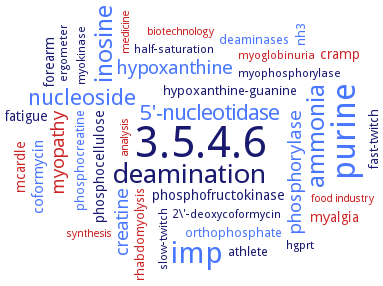3.5.4.6: AMP deaminase
This is an abbreviated version!
For detailed information about AMP deaminase, go to the full flat file.

Word Map on EC 3.5.4.6 
-
3.5.4.6
-
purine
-
imp
-
deamination
-
inosine
-
ammonia
-
nucleoside
-
5'-nucleotidase
-
hypoxanthine
-
creatine
-
phosphorylase
-
myopathy
-
coformycin
-
mcardle
-
fatigue
-
phosphofructokinase
-
myalgia
-
forearm
-
phosphocellulose
-
cramp
-
athlete
-
hypoxanthine-guanine
-
phosphocreatine
-
fast-twitch
-
deaminases
-
orthophosphate
-
nh3
-
rhabdomyolysis
-
myokinase
-
slow-twitch
-
half-saturation
-
myoglobinuria
-
ergometer
-
myophosphorylase
-
2\'-deoxycoformycin
-
hgprt
-
medicine
-
biotechnology
-
food industry
-
analysis
-
synthesis
- 3.5.4.6
- purine
- imp
-
deamination
- inosine
- ammonia
- nucleoside
- 5'-nucleotidase
- hypoxanthine
- creatine
- phosphorylase
- myopathy
- coformycin
- mcardle
-
fatigue
-
phosphofructokinase
- myalgia
- forearm
-
phosphocellulose
- cramp
-
athlete
-
hypoxanthine-guanine
- phosphocreatine
-
fast-twitch
- deaminases
- orthophosphate
- nh3
- rhabdomyolysis
- myokinase
-
slow-twitch
-
half-saturation
- myoglobinuria
-
ergometer
- myophosphorylase
-
2\'-deoxycoformycin
- hgprt
- medicine
- biotechnology
- food industry
- analysis
- synthesis
Reaction
Synonyms
5'-adenosine monophosphate deaminase, 5'-adenylic acid deaminase, 5-adenylate deaminase, 5-adenylic acid deaminase, 5-AMP aminohydrolase, 5-AMP deaminase, adenosine 5-monophosphate deaminase, adenosine 5-phosphate aminohydrolase, adenosine 5-phosphate deaminase, adenosine monophosphate deaminase, adenosine monophosphate deaminase 3, adenosine monophosphate deaminase-1, adenosine-5'-monophosphate deaminase, adenyl deaminase, adenylate aminohydrolase, adenylate deaminase, adenylate desaminase, adenylic acid deaminase, adenylic deaminase, AMP aminase, AMP deaminase, AMP deaminase 3, AMP deaminase H-type, AMP deaminase isoform E, AMP deaminase type 3, AMP deaminase1, AMP-aminohydrolase, AMP-deaminase, AmpD, AMPD1, AMPD2, AMPD3, AMPDA, deaminase, adenylate, embryonic factor 1, EMBRYONIC FACTOR1, Erythrocyte AMP deaminase, FAC1, Heart-type AMPD, muscle AMP deaminase, Myoadenylate deaminase


 results (
results ( results (
results ( top
top





